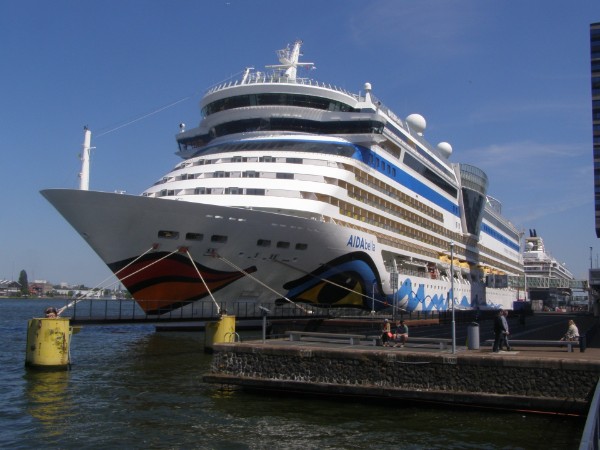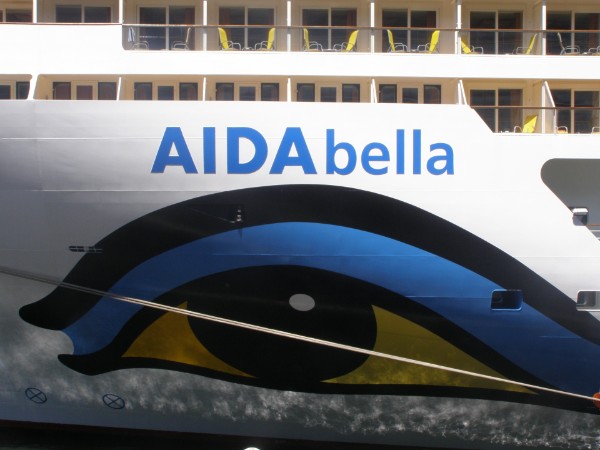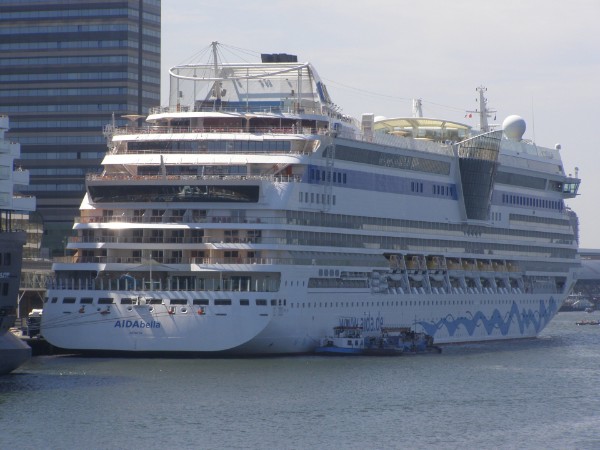AIDAbella
The Sphinx-class, as we all know, was a series of ten postships from the Royal Navy, designed in 1773 and built between 1775 and 1781 on several English Naval yards. They had a tonnage of 431 and were 33 meters long. Of course, the first ship, built in Portsmouth in 1775, was named Sphinx, so that is why the name Sphinx-class... Oh, here we are talking about another class of ships I guess...

The second Sphinx-class ship AIDAbella in Amsterdam at the 4th of june 2015.
Background
In october of 2004, Carnival Corporation had ordered two thirth-generation clubships from the Meyer Werft at Papenburg, northern Germany for AIDA Cruises. The ships were going to have a tonnage-measurement of around 68.000 tons and the class was dubbed the Sphinx-class. Already one month later, a thirth ship was also ordered. Originally, the deliverydates for the two-ship order was 2007 and 2009, but the thirth ship was now to be delivered in between and sceduled for 2008. This reflects in the yardnumbers under which the ships were built, the first one AIDAdiva recieved yardnumber S.659, the second ship AIDAbella was built under yardnumber S.666 and the thirth ship, AIDAluna that was thus ordered earlier, was built under yardnumber S.660. Still more ships followed, but those were slightly bigger with the addition of one extra deck. Mostly referred to as Sphinx-class ships too, they are officially known under another class-name, the Ikarus-class. Within this Ikarus-class, the AIDAblu was delivered in 2010, followed by AIDAsol in 2011, AIDAmar in 2012 and AIDAstella in 2013. With these seven ships, AIDA Cruises started to become one of the largest European cruiselines and one of the most profitable within the portfolio of the Carnival Corporation. So the Sphinx-class and Ikarus-class of AIDA Cruises weren't named after the first ships like those English postships, but the Egypt-orientated name seemed well-chosen because the story of Aida, originally written by Verdi, played in Egypt. This is also where the hullart of the ships come from, as its designer Feliks Büttner got his inspiration from Egyptian hieroglyphics. The name for AIDAbella, the second in the class of seven, was chosen because it made clear how beautifull this new class of ships was and, not forgetting, the perfect shape of them.
Construction and general statistics
The keel for this shapely beauty was laid at the 10th of march of 2007 at the Jos L. Meyer Werft at Papenburg, norhern Germany. She has a tonnage of 69.203 and she is 251,89 meters long, 32,19 meters wide and has a draft of 7,50 meters. She is driven by four Caterpillar MaK-designed diesel-electric engines giving her a speed of around 19,5 knots in normal service, with a stated maximum of 21,8 knots. On her 14 decks, there is space for a maximum of 2500 passengers and 646 crewmembers. On the 19th of october of 2007, the ship left her building shed at the wharf to be brought over to the fitting-out basin and she passed the river Ems for her trials towards the port of Emden at the 27th of march 2008. After those succesfull traials, the ship was finally handed over to AIDA Cruises at the 14th of april of that same year.
Design and concept
In her passenger and crewnumbers, you'll see that is a little lower in ratio than normally. This is because AIDAbella and her sisters are clubships, with several differences from other cruiselines. There is no main restaurant aboard the AIDA ships, but four buffet-style restaurants next to one a-la-carte restaurant and two specialityrestaurants. The restaurants do not have seatings, you can dine when you like, with who you like, in which restaurant you like and how long you like. But do not think that makes the quality less great, all is made fresh and there is even a very good amount diet-information available. This style is very informal and it also saves a lot of waiters, making the overall price cheaper. There also is no theater aboard AIDAbella, she has, like all of her sisters, the Theatrium, which is of course a combination of a theater and an atrium. This space is set on three decks and has a floorspace of around 3000 square meters. The concept of the Theatrium came from the house-designers of the AIDA fleet, the Hamburg-based Partner Ship Design. This company is not only responsible for this space, but is the designer of all interiour spaces of the ship.
There are 1015 cabins aboard, of which 439 have their own balcony, 209 are outside-cabins and 349 are insides. There are also 18 suites. Eleven bars are there to get something to drink, there is a 'body and soul' fitness and beauty-area that measures around 2300 square meters and the ship also offers 6400 square meters of open decks. The ship is decorated in a very modern style with modern artworks and light and bright colourscemes. One of the passenger-favorites is the Aida-Bar, where the centerpiece is the bar itself, designed in the shape of a compass-rose so interaction with other passengers is very easy and there are also many seats at the bar itself. The ship also has a modern art-gallery and a large shopping area, a spacious lounge that overlooks the bow of the ship and a very open-styled casino next to the Theatrium. Several of the inside spaces have a tropical touch as they are decorated with real-looking palmtrees.
You can almost say AIDAbella and her sisters are Freestyle-plus as the informality aboard is to be noticed everywhere. There is no Captains Gala, no formal nights where you have to dress up and no nothing you 'have' to do. Where several other cruiselines are luxury-hotel style, AIDA Cruises offers family-hotel style for the mass, without giving you the feeling that it is less desirable. Their style just is exactly for the working-class of people, searching for a holiday with just something extra then they are used to. Yes, just about everyone with a normal day-to-day job. Because Carnival Corporation has placed AIDA Cruises under the banner of Costa Cruises, the ships are registered at Genua, the traditional Costa Cruises homeport so AIDAbella flies the Italian flag, although she is definitely a German ship. The main language aboard the ship is German, but all crewmembers do know their English also.

Carreer
At the 23rd of april of 2008, the ship was christened by international model Eva Padberg as the fifth ship within the fleet of AIDA Cruises. The ceremony was held in the port of Warnemünde in northern Germany and scenes from the new show 'Avalon' were played, as well as a performance by the Berlin Symphony Orchestra. Also Volkan Baydar, a member of the popduo Orange Blue, performed a specially written christening song. A day after the ceremony, the ship set sail for he first Baltic cruise calling at Bergen, Oslo, Göteborg and Copenhagen, before returning to Warnemünde.
In the fall of 2010, AIDAbella had the honour to be given a place in the Guiness Book Of World Records when she was awarded the record of having somebody on waterskis behind a cruiseship for the longest time. Near Alicante, Spain, at a speed of 14 knots, the German TV-reporter and journalist Jan Schwiderek was skiing behind the ship for six minutes over a distance of 250 meters.
Since her debut, the ship has sailed the Baltic, Mediterranean and the Canaries, as well as Canada and New England and the Caribbean. In the spring of 2016, AIDAbella was the choice when AIDA Cruises entered the Chinese market. The most recent goldmine for the worlds cruiselines has seen spectacular growth over the years before and from 2016 onwards, AIDAbella was to be stationed yearround at Shanghai for Eastern cruises in the Chinese market from the 2017 season onwards. For this service, the ship was going to be updated to cater for the special needs for Chinese passengers, but the company also wanted to keep the German image of the line, seperating them from all other lines flooding the Chinese market. But in september of 2016, AIDA stated that the Chinese venture of the ship was postponed and the ship was going to sail Mediterranean cruises instead. Also Carnival itself earlier postponed their Chinese venture and so it seems that the industry now recognises that all added capacity was not creating the expected growth in China on such a short timescale.


